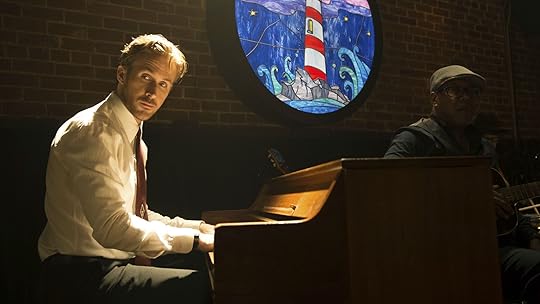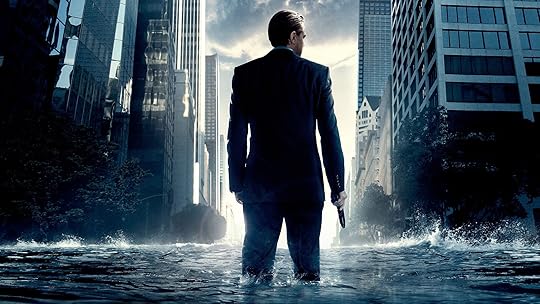How Symbolism Shapes Modern Narratives.
Picture this: You’re watching a movie, or reading a book, and suddenly…bam! There’s something in the background, a minor detail, a subtle hint that makes you go, “Wait a second, what’s that all about?”
Maybe it’s a colour, an object, or even an eerie silence. That, my friend, is symbolism at work, quietly doing its thing, deepening the story and giving you all the feels.
Symbolism isn’t just a cool trick up a writer or director’s sleeve. It’s the magic dust that makes a story sparkle and stick with you long after you’ve turned off the TV or closed the book. While everyone talks about colour, nature, and objects as symbols (and for good reason), let’s dive into some fresh ways symbolism is popping up in movies and books over the last 10-15 years.
Ready for a wild ride through the world of hidden meanings? Here we go!
5 Ways Symbolism Transforms Modern Storytelling.

#1 – Techy Symbols: Are We More Human or More Alien?
We’re living in a digital world, right? Social media, A.I., virtual realities… it’s all around us. So it’s no surprise that technology has become the ultimate symbol in recent stories.
In the hands of creative geniuses, tech isn’t just a tool, it’s a reflection of who we are, or maybe who we’re becoming.
Take “Ex Machina”, it’s more than just a slick sci-fi flick. The AI, Ava, is this cold, calculating, gorgeous machine. But symbolically? Ava is both the pinnacle of human achievement and a terrifying glimpse into a world where technology no longer needs us. She’s a reminder that in our quest to be the smartest species, we might end up creating something that makes us feel… well, obsolete.
And in “Black Mirror” (a whole series packed with tech symbolism), things get even crazier. In the episode “Nosedive”, social media ratings take over people’s lives, think of it as Instagram on steroids.
Your value as a person? It’s based on how many likes you get. It’s hilarious, it’s terrifying, and it’s definitely a symbol for how obsessed we’ve become with online approval and validation. It’s not just about tech, it’s about what tech is doing to our humanity
 #2 – Cities: The Concrete Jungle Inside Our Heads.
#2 – Cities: The Concrete Jungle Inside Our Heads.
We often think of cities as just… cities. But in modern stories, urban landscapes have become totally symbolic. The hustle and bustle of skyscrapers, the neon lights, and the endless noise, what if they represent our own mental chaos?
Welcome to the world of symbolism in city settings, where the concrete jungle mirrors emotional turbulence, growth, and everything in between.
“Blade Runner 2049” is a prime example. The sprawling, bleak, neon-lit Los Angeles isn’t just a setting; it’s a visual metaphor for the internal conflict of the main character, K.
The city is decaying, polluted, and lifeless, just like K’s perception of his own identity. The more he digs into his personal journey, the more the city’s dark and lonely vibe feels like a reflection of his inner turmoil. Cities can represent isolation, moral decay, or even hope, depending on how the story wants to spin it!
Then there’s “The Dark Knight”, where Gotham City is like this wild mix of a pressure cooker and a moral battleground. The city’s crime-ridden streets and towering buildings aren’t just cool backdrops, they show the moral chaos and power struggles of the characters, especially Batman and the Joker.
Gotham isn’t just Gotham; it’s a living, breathing symbol of the choices we make when faced with evil.

#3 – Music and Sound: Not Just for Background Vibes.
You know how the right soundtrack can turn an ordinary scene into something extraordinary? Music and sound have long been used to set the emotional tone of a scene, think triumphant orchestras for battle scenes or soft piano for tender moments.
But modern filmmakers and storytellers are taking it to a whole new level, using sound not just to accompany the action, but to symbolise the emotional core of the story itself. It’s like the music becomes a secret character, guiding you through the character’s psyche.
Let’s start with “La La Land”, a movie that’s all about the highs and lows of following your dreams and finding love. But the music isn’t just there to make you want to dance; it’s deeply symbolic of the emotional arc of the characters.
Take, for example, the jazz Sebastian plays in his club. It’s not just a musical style; it symbolises his personal struggle to keep his artistic integrity in a world that’s constantly pulling him in other directions. As the movie progresses, the music reflects the tension between his relationship with Mia and his dreams.
The soaring, bold scores during their moments of joy contrast with the sombre, more reflective tones when they face tough decisions. It’s as if the music is saying, “These are the emotions you can’t express in words.”
In “Her”, music is used even more subtly but with just as much impact. The soft, ambient soundtracks are like an emotional map for Theodore’s journey. At the beginning, the music feels a little distant, mirroring Theodore’s loneliness and emotional detachment.
But as he grows closer to the AI, Samantha, and opens up to his own feelings, the music shifts in tone, softer, more intimate, and, dare I say, more hopeful. The way music swells and recedes tracks his internal transformation, making us feel exactly what he’s going through without a single word being spoken.
Music and sound, when used in this symbolic way, can dig deeper than any dialogue could. They help us understand the emotional undercurrents of a story, filling in the gaps between what the characters say and what they truly feel. Whether it’s the melancholy tones of a jazz piano, the ambient whispers of an electronic score, or the silence that speaks volumes, these elements give modern stories an emotional depth that resonates long after the credits roll.

#4 – Memory and Time: When Time Bends and Memory Gets Messy.
Here’s something we all can relate to: how time feels is not always how it works. Time flies when you’re having fun and drags when you’re stuck in a waiting room. And when it comes to memory, well, that’s even trickier.
Have you ever tried to recall a moment, only to realise that your memory of it is a little hazy, or even entirely different from someone else’s recollection?
Time and memory aren’t just tools for storytelling; they are symbols that shape the entire emotional experience of modern films and books.
“Inception” plays with the very fabric of time. Dream worlds don’t obey the rules of reality, which is exactly why they make such a powerful metaphor for the human psyche. In the dream layers, time stretches and bends; what feels like hours in a dream can pass in mere minutes in the real world.
This manipulation of time isn’t just a narrative device; it’s symbolic of how memory and perception work.
Just like in dreams, our memories can become distorted or out of order, and our perception of time often has nothing to do with what actually happened. The deeper Cobb and his team go into the dream layers, the more the boundaries between past and present, reality and illusion, blur.
The movie challenges us to think about how we construct our memories and what they say about who we are.
In “Eternal Sunshine of the Spotless Mind”, time and memory are central to the story’s emotional impact. The entire plot revolves around the process of erasing memories of a failed relationship, but here’s the catch: the more the characters try to forget, the more they realise they want to remember.
The movie shows us that even painful memories are part of who we are. Time, in this case, isn’t linear. It’s messy and fragmented, just like the way we experience life. The film uses the erasure of memories to symbolically represent how we often try to rid ourselves of the pain of the past, but in doing so, we lose the lessons and emotional growth that come with those memories.
The beauty of these films is how they use time and memory to symbolise the human struggle with regret, identity, and acceptance.
Both “Inception” and “Eternal Sunshine” ask profound questions: What is the cost of revisiting painful memories? What does time really mean in the context of our lives? By manipulating time and memory in such creative ways, these stories tap into universal emotions, helping us connect with the characters on a much deeper, more visceral level.
These symbolic explorations of memory and time serve as reminders that life itself isn’t always neat and tidy. Our memories shape us in ways we might not even realise, and time, well, it’s a lot less dependable than we think.

#5 – Silence: The Unsung Symbol.
In a world that never stops talking, silence can say a lot. When used strategically in stories, silence becomes a potent symbol of tension, isolation, or reflection. It’s not just about being quiet, it’s about what’s left unsaid, what’s unheard.
In “A Quiet Place”, the need for silence isn’t just about survival from monsters (although, you know, that’s a big part of it).
It symbolises the emotional restraint and trauma the characters have experienced. It’s also a reminder of how we communicate with each other when words aren’t enough. Silence becomes a symbol of loss, love, and the strength to protect.
In “The Artist”, the transition from silent films to talkies is symbolic of the fear of obsolescence.
The characters must adapt to a changing world, and the silence in the early part of the movie symbolises the protagonist’s growing isolation and the struggle to find his place in a world that’s moving forward without him
Wrapping It Up: Symbolism is the Secret Sauce!
And there you have it, symbolism isn’t just for deep thinkers or literary nerds; it’s the secret sauce that takes a good story and turns it into something unforgettable. Whether it’s through technology that reflects our anxieties about the future, urban landscapes that mirror emotional chaos, or music and sound becoming the unsung heroes of a film’s emotional depth, modern stories are packed with symbolism that enriches every single frame or sentence.
The brilliance of symbolism lies in its subtlety. It’s often there in the background, waiting for us to catch on and make the connection. When done right, symbolism doesn’t just tell you what’s happening, it helps you feel it, often on a deeper level. It challenges us to look beyond the surface, to interpret what’s unspoken, and to reflect on the emotional and philosophical currents that drive the story.
Next time you’re diving into a book or movie, try to tune in to the symbols at play. Whether it’s a piece of music that resonates with a character’s journey, a city that feels like the emotional state of its residents, or the manipulation of time that mirrors the complexity of human experience, these symbols are there for a reason.
And once you start noticing them, you’ll see how they make stories even richer, deeper, and more real. Now go ahead, grab that book, press play on that movie, and uncover the hidden gems that make stories truly come alive!
Now it’s YOUR turn – What’s a symbol in a story that’s stuck with you?
Would love to get your input in the comment box below.
The post How Symbolism Shapes Modern Narratives. appeared first on Vered Neta.



